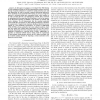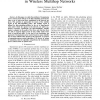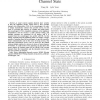GLOBECOM
2010
IEEE
13 years 9 months ago
2010
IEEE
Providing air-time guarantees across a group of clients forms a fundamental building block in sharing an access point (AP) across different virtual network providers. Though this p...
GLOBECOM
2010
IEEE
13 years 9 months ago
2010
IEEE
Motivated by the recent concept of Space-Time Shift Keying (STSK), we propose a novel cooperative STSK scheme, which is capable of achieving a flexible rate-diversity tradeoff, in ...
GLOBECOM
2010
IEEE
13 years 9 months ago
2010
IEEE
In this paper, we propose a novel Space-Time Shift Keying (STSK) modulation scheme for MIMO communication systems, where the concept of spatial modulation is extended to include bo...
GLOBECOM
2010
IEEE
13 years 9 months ago
2010
IEEE
Multi-gigabit per second wireless network devices are emerging for personal area networks (PAN) in the 60 GHz band. Such devices are typically power hungry, largely due to the requ...
GLOBECOM
2010
IEEE
13 years 9 months ago
2010
IEEE
Scheduling of delay-tolerant jobs has been proposed as a mechanism to alleviate pressure on congested network resources. However, when multiple competing users share these resource...
GLOBECOM
2010
IEEE
13 years 9 months ago
2010
IEEE
In this paper, we study the problem of transmission power control and its effects on the link-scheduling performance when a set of end-to-end flows established in the network are g...
GLOBECOM
2010
IEEE
13 years 9 months ago
2010
IEEE
The aviation community is currently working on the standardization of data communication systems for the future air traffic management. In this context, the ICAO and EUROCONTROL ar...
GLOBECOM
2010
IEEE
13 years 9 months ago
2010
IEEE
Duty cycling is often used to reduce the energy consumption caused by idle listening in Wireless Sensor Networks (WSNs). Most studies on WSN protocols define a common duty cycle va...
GLOBECOM
2010
IEEE
13 years 9 months ago
2010
IEEE
A usual concern against physical layer security is that the legitimate parties would need to have (partial) channel state information (CSI) of the eavesdropper in order to design t...
GLOBECOM
2010
IEEE
13 years 9 months ago
2010
IEEE
FCC requires that any white space device be able to sense wireless microphone (WM) signals at -114dBm typically corresponding to a SNR of -20dB, an extremely challenging task. This...



